Chapter II. Soil Cultivation. Digging
Description
This section is from the book "School Gardening", by W. Francis Rankine. Also available from Amazon: School Gardening.
Chapter II. Soil Cultivation. Digging
The object of all digging operations is to enable the forces of nature to carry on their work to the greatest extent; at the same time weeds are cleared from the garden. The digging of loams and clays should be done in late autumn or early winter and the surface should be thrown up roughly. This encourages the free admission of water, and as this expands under the influence of frost, the lumps are forced to pieces and the cultivator is able, when the time for seeding or planting comes in spring, to secure a friable, mellow tilth, or " season." The frost also kills many insects and other garden pests. The grower benefits still further by frost action when the soil is thrown up roughly ; numerous air passages are formed, the soil is thoroughly aerated, and the latent food supplies are converted into a rich store of available nutrient matter. No gardener can reasonably expect any measure of success if this winter digging of medium or strong land is neglected or imperfectly carried out.
The ground should be forked again in spring to facilitate the preparation of suitable seed beds ; if, however, the winter digging has not been performed, weeds are well established, and the actions of frost and air will be lost.
It is necessary, however, to consider sandy soils whose composition is such that they lack the power of holding moisture, and, consequently, cannot hold plant food in suspension. To dig these deeply and roughly in autumn would mean that the water would pass through them more easily and more rapidly than before, and what little nutrient matter they contained would be washed away. Such light soils should be worked as early in spring as the weather permits.

Fig. 2. digging.
The soil from the trench A is taken to B and the earth in C is thrown forward into the empty trench. When D is reached it is filled with the soil taken from A. Thus total displacement of soil is achieved.
In digging, great care must be taken to displace the soil. Form a trench, one spade in depth and two feet in width along one end of the plot, and by the aid of a wheelbarrow take it to the other end, or side if the plot has been divided longitudinally. The reason for this process is quite clear, for, as the soil is moved a spadeful at a time, until the piece of ground is dug, a trench is always open. This is filled with the soil that was taken in the first place from the opposite end of the plot. If the soil has been evenly turned, the freshly-dug plot will present a level surface ; on the other hand, if the digging has been done unevenly and imperfectly, the surface will be uneven and untidy. The spade should be pressed into the ground so that the blade slants at an angle of about 60° ; the spadeful of earth that is raised should be thrown forward so that the soil is turned completely over. If the spade is inserted too slantingly, the soil will not be worked to a sufficient depth, for, as we have noticed, the deeper is the soil, the greater is its capacity for holding plant food. Shallow digging, therefore, is of little value. It is imperative that the bottom of each trench should be well forked before the next portion of soil is dug in. This increases the depth of soil and generally improves the value of the garden ; a larger supply of plant food is secured, and the roots of the plants ramify more readily and more deeply into the ground.

Fig. 3. Incorrect And Correct Methods Of Digging.
In Fig. A the spade is inserted too obliquely and hence the soil is moved to a less depth than it is in Fig. B in which the spade is placed correctly.
Continue to:
